Mark Sisson's Blog, page 242
November 21, 2015
Braised Turkey Legs with Fennel and Artichoke Hearts
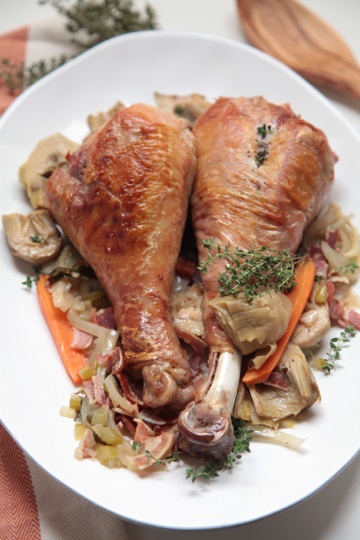 When whole turkeys start showing up in grocery stores, so do turkey drumsticks. These are not dainty drumsticks. They are caveman style eating, drumsticks that weigh in around a full pound each. Roasted and carved, and served with sides, one drumstick can make a meal for two people. If you’re someone who loves dark turkey meat, or if turkey one day a year just isn’t enough, then braised turkey drumsticks are a meal you’ll love.
When whole turkeys start showing up in grocery stores, so do turkey drumsticks. These are not dainty drumsticks. They are caveman style eating, drumsticks that weigh in around a full pound each. Roasted and carved, and served with sides, one drumstick can make a meal for two people. If you’re someone who loves dark turkey meat, or if turkey one day a year just isn’t enough, then braised turkey drumsticks are a meal you’ll love.
Turkey drumsticks can be cooked alongside a whole turkey, for more dark meat, or cooked in place of a whole turkey. (If you can find turkey thighs, they can be cooked using this same method.) The drumsticks braise uncovered (so the skin isn’t soggy) and there’s little risk of the meat drying out, like turkey breast often does.
All in all, you’re getting the best, most flavorful part of the bird for less money with less cooking stress involved. Sounds the perfect holiday meal, doesn’t it?
Servings: 4
Time in the Kitchen: 35 minutes hands-on, plus 2 hours to cook turkey
Ingredients:
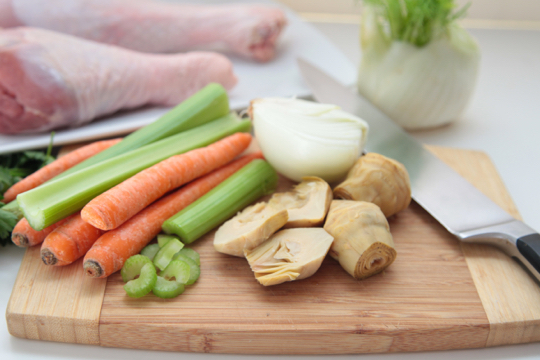
2 to 3 large bone-in, skin-on turkey drumsticks
2 tablespoons extra virgin olive oil (30 ml)
.25 ounces pancetta or bacon (7 g)
4 stalks celery, chopped
1 onion, finely chopped
1 fennel bulb, cut in half and thinly sliced
6 carrots, halved lengthwise
9 to 12 ounces artichoke hearts, drained and cut in half (255 to 340 g)
1 bay leaf
4 thyme sprigs
6 parsley sprigs
4 cups chicken or turkey stock (950 ml)
Instructions:
Preheat the oven to 325 °F/163 °C.
Season drumsticks liberally with salt and pepper.
Pour the olive oil in a large deep skillet over medium-high heat. When it’s hot, add the drumsticks and brown all over, about 8 to 10 minutes. Transfer drumsticks to a roasting pan that is slightly smaller than what you’d use for a whole turkey.
Add the bacon or pancetta to the skillet and cook until just barely crisp. Transfer to the roasting pan.
Add celery, onion, fennel and carrots to the skillet and cook until the vegetables are soft and beginning to brown, 10 minutes. Season with salt. Add stock to the skillet and bring to a simmer. Pour the stock and vegetables into the roasting pan.
Add artichoke hearts, bay leaf, thyme and parsley to the roasting pan.
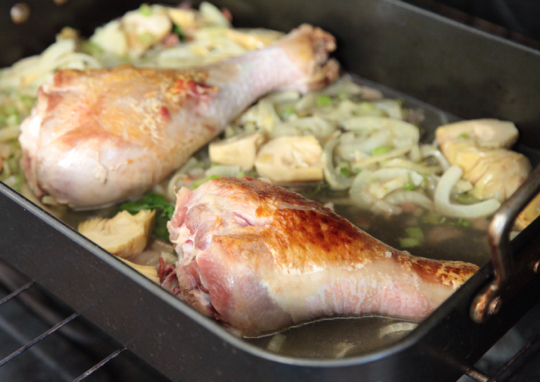
Roast about 2 hours, uncovered, until the skin is browned and the meat tender, and an instant-read thermometer inserted in the thickest part registers 165 °F/71 °C. Stir the vegetables occasionally to prevent burning. If the pan begins to look dry, add a little more stock.
Remove the drumsticks. Use a slotted spoon or strainer to separate the liquid from the vegetables. Arrange the vegetables around the drumstick. Bring the liquid to a simmer on the stove to reduce slightly, and pour over the drumsticks before serving.
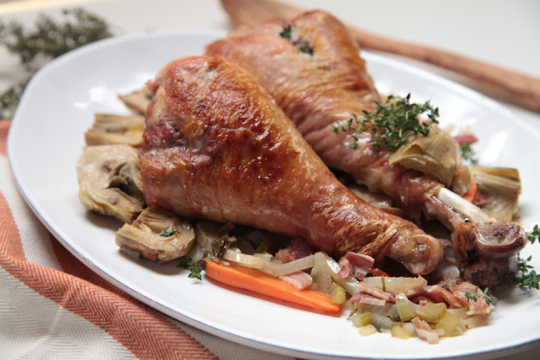
Not Sure What to Eat? Get the Primal Blueprint Meal Plan for Shopping Lists and Recipes Delivered Directly to Your Inbox Each Week. Now Available as an App!



November 20, 2015
On the Path to Healing: 30 Pounds Down and IBS Under Control
It’s Friday, everyone! And that means another Primal Blueprint Real Life Story from a Mark’s Daily Apple reader. If you have your own success story and would like to share it with me and the Mark’s Daily Apple community please contact me here. I’ll continue to publish these each Friday as long as they keep coming in. Thank you for reading!
 My story is not as huge of a success story as other people I have read about, but then again, I did not start out completely unhealthy.
My story is not as huge of a success story as other people I have read about, but then again, I did not start out completely unhealthy.
I was always really active growing up and I was a dancer as well. I never ever struggled with my weight and ate whatever I wanted. I never could understand how people could get overweight—after all it was easy for me! I stayed slim and lean through dance and just a generally active lifestyle.
I danced for most of my early years, and stopped when I reached college. I had terrible eating habits by then. I ate anything I wanted at the time, because that was what I always did when I danced. However, when I was eating the same way at college, I started to gain weight. Then I started to get cravings that would not go away until I had said item. Cheeseburgers, french fries, and everything else bad for me, were my staples.
 After I entered grad school, I developed severe IBS. Every day I would get terrible cramps that would not go away. I would get constipated for three days at a time, every two weeks or so, then have horrible diarrhea. I wore sweat pants all the time because it hurt too much to wear tight pants. I actually landed in the ER with colitis and was quite literally filled with crap. I could not eat for three days. In sum, I was really sick most days and I had gained 40 lbs since college. I was shocked when I looked at the scale. After that I stopped looking.
After I entered grad school, I developed severe IBS. Every day I would get terrible cramps that would not go away. I would get constipated for three days at a time, every two weeks or so, then have horrible diarrhea. I wore sweat pants all the time because it hurt too much to wear tight pants. I actually landed in the ER with colitis and was quite literally filled with crap. I could not eat for three days. In sum, I was really sick most days and I had gained 40 lbs since college. I was shocked when I looked at the scale. After that I stopped looking.
I actually started paleo because my parents did. Their story is actually much better than mine. They kept sending pictures of themselves and they had lost a ton of weight (my dad lost 50 lbs) and I asked what they had been doing. Their eating habits had drastically changed as well. So I checked into this whole paleo thing. I did not get it to begin with and it made no sense to me. My mom actually came for a visit with my husband and I. She made a paleo dinner for us and it all clicked. After that I was hooked.

I did research constantly that first week. My mom was the one who got me started on some basic research to help me understand everything. She told me about Mark’s Daily Apple. I fondly call it my “paleo bible.” It was my “go to” for any questions I had regarding paleo and what I should eat and what could cause harm if I did. In one week I had cut out bread, gluten, starches (like potatoes and corn), and reduced my sugar intake to almost nothing.
For a while I had fruit with my lunch everyday, especially apples and pears. I actually got stomach cramps and I found out I have a fructose sensitivity. I then reduced any fruit that I would normally have to either half, or consumed fruits or veggies with a lower sugar content. As for carbs, I cannot cut them out completely because it causes too many problems with my system, especially as a woman. I did it at first, but my system went into complete shock and things started to go awry. As a result, I only consume healthy carbs but I do not go overboard. After being on paleo for a while, I noticed that consuming any unhealthy carbs causing mild swelling in my body and especially my face. I try to avoid them. Corn also caused itchiness all over – so I try to avoid it.
 My IBS is completely under control now. It is not completely gone, but it takes some time for the gut to heal. I stopped having most cravings – though they were intense for the first week and a half. I definitely had “carb fever” at the beginning! When or if I have cravings, I try to retrain my brain that I want that good time associated with eating that particular food, not the food itself. I actually prefer a general empty feeling in my stomach, rather than the over-full feeling that I had after eating—a 100% change from before paleo. I also noticed that I need less sleep than I used to and have so much more energy. I eat at home a lot now, and I have to get creative to avoid the foods I used to eat. I enjoy different things now, and I have lost 30 lbs altogether.
My IBS is completely under control now. It is not completely gone, but it takes some time for the gut to heal. I stopped having most cravings – though they were intense for the first week and a half. I definitely had “carb fever” at the beginning! When or if I have cravings, I try to retrain my brain that I want that good time associated with eating that particular food, not the food itself. I actually prefer a general empty feeling in my stomach, rather than the over-full feeling that I had after eating—a 100% change from before paleo. I also noticed that I need less sleep than I used to and have so much more energy. I eat at home a lot now, and I have to get creative to avoid the foods I used to eat. I enjoy different things now, and I have lost 30 lbs altogether.
Thanks so much for all you do,
Elizabeth




November 19, 2015
What Will Happen with Mark’s Daily Apple?
 This year, my team and I spent a significant amount of time revamping the PrimalBlueprint.com website. If you haven’t checked it out yet, head on over there after you read today’s blog post. It’s streamlined, fresh, and easy to navigate. As we look ahead to 2016, we have another big website overhaul…this time of Mark’s Daily Apple.
This year, my team and I spent a significant amount of time revamping the PrimalBlueprint.com website. If you haven’t checked it out yet, head on over there after you read today’s blog post. It’s streamlined, fresh, and easy to navigate. As we look ahead to 2016, we have another big website overhaul…this time of Mark’s Daily Apple.
Some of you may remember the original version of the site. It had a good run from 2006 to 2009, but boy does it look dated now:

I haven’t done any major remodeling of the blog since we made the jump to the current version of the site, and I think it’s time to renovate. But I don’t want to do it alone! I’d love the advice of the people that make Mark’s Daily Apple such a success. That breathe life into its veins on a daily basis. I need YOU to help me bring MDA into the future, because we’re on this primal path together.
I want to know how I can make Mark’s Daily Apple better for you. What can I give you in terms of articles, features, functionality…how specifically would you like to see MDA improved? More videos, daily fitness tips, weekly health challenges? And feel free to share anything that drives you crazy about the current site. For instance, if there’s a regular column you’d like nixed from the mix, let me know. Hate how the comment board works? I’m all ears. Can’t stand the mobile version of MDA? Tell me what you dislike. Any color schemes or design elements you’d like to see implemented? Toss them in the bag for consideration! And don’t be shy about your requests.
Just click here to take a short survey and let me know how you’d like Mark’s Daily Apple to be upgraded and redesigned. Please, don’t leave me hanging! I can’t wait to see how MDA evolves in the new year.
Thank you for being part of this ongoing story with me. Grok on!
Like This Blog Post? Subscribe to the Mark's Daily Apple Newsletter and Get 10 eBooks and More Delivered to Your Inbox for FREE



November 18, 2015
A Case Against Cardio, Part 27
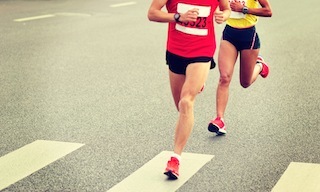 (I’m mostly joking with the title. It’s actually Part 18.) Endurance training has been getting the snot beaten out of it in recent years. And not just on this blog. A variety of media outlets, TED talks, other blogs, observational research and clinical trials have all sounded the alarm about the dangers of excessive chronic cardio.
(I’m mostly joking with the title. It’s actually Part 18.) Endurance training has been getting the snot beaten out of it in recent years. And not just on this blog. A variety of media outlets, TED talks, other blogs, observational research and clinical trials have all sounded the alarm about the dangers of excessive chronic cardio.
A new string of studies has found evidence of higher arterial plaque levels in the most active endurance athletes. This is becoming a trend. While endurance athletes tend to have more of the calcified kind of plaque, which is more stable and theoretically less prone to dangerous ruptures than less-calcified plaque, it remains worrying. I’ve spoken in the past about the proclivity toward heart problems found in endurance athletes. I know many former peers with atherosclerosis, cardiac arrhythmias, and other heart troubles.
As disconcerting as that is, that’s not what today’s post is about.
Today, I’m asking, “What’s the point?”
The whole “this thing will kill you” tactic is helpful from time to time, but more effective is the utility argument: what works better? What gets you fitter, faster, stronger, and sexier?
In recent years, researchers have been running direct head-to-head comparisons between traditional endurance training and more intense forms of exercise, like strength training or sprint interval training. They almost always end badly for cardio. How badly?
Let’s find out:
A recent review asked an important question: what’s better for altering body composition—resistance training alone, endurance training alone, or endurance training with resistance training?
Resistance training won, leading to greater fat loss and retention of lean muscle mass. Furthermore, RT alone was better at reducing fasting insulin levels and improving blood lipids.
The only way the authors were able to find endurance training helpful was by including high intensity interval training in the endurance category. Their overall conclusion was that the “focus of treatment” for people interested in losing body fat should be on producing a large metabolic stress via intense strength training and/or interval training.
This jibes with other recent papers:
Endurance training burns more belly fat when you incorporate strength training.
In obese teens, strength training alone reduced body fat more than endurance training or combined endurance/strength training.
In women with PCOS, both strength training and interval training reduce body fat and improve insulin resistance without affecting body weight, which indicates gains in lean muscle mass. In another study, women with PCOS who engaged in standard moderate cardio improved endothelial function but lost no body fat.
It’s surprising, isn’t it? You’d assume that although strength training is definitely great for health, fitness, and body composition, adding in some endurance work could only improve those metrics even more. Sometimes, that’s true, but in the majority of studies, this just isn’t the case. Strength training or interval training alone are generally superior.
How about “unhealthy” people with conditions like heart failure or diabetes? Aren’t they too fragile to endure resistance training or high intensity intervals? Wouldn’t an hourlong jog be a better, safer use of their time?
In September, patients with heart failure (with preserved injection fraction) were placed on one of two exercise modalities: continuous medium-intensity cardio (30 minutes at 70% maxHR) or high-intensity interval training (4×4 minutes at 85-90% maxHR; 3 minutes rest). HIIT resulted in numerous improvements to arterial function and ventricular volume. The HIIT group even improved their cardiovascular fitness, with VO2max going up. The cardio group saw no improvements at all.
Other studies have found that endurance training can improve VO2max in heart failure patients but has little effect on markers of endothelial function or arterial stiffness.
Recently, researchers compared the effects of endurance training to either resistance training or HIIT on microvascular function in type 2 diabetes. Microvascular function refers to the system of tiny, precious little capillaries delivering blood and nutrients to individual cells and tissues. Poor microvascular function predicts future cardiovascular problems, so it’s really important. They found that the training modalities which employed the most amount of muscle tissue produced the biggest improvements. As most traditional endurance training localizes muscle recruitment, while HIIT and strength training tend to target the entire body, that’s a roundabout way of saying strength training and HIIT trounced endurance training.
Other diabetes researchers examining this exact issue are quick to say that “more exercise is not better” and that it’s all in how you exercise. You can’t just do something that gets you winded and hope you’re destroying your glucose intolerance, insulin resistance, and normalizing your glucose levels. You have to train the glucose sinks—the actual muscles that will be accepting (or rejecting) the glucose. And the absolute best way is to move those muscles, particularly vigorously. Jogging through your neighborhood or cycling for three hours just doesn’t cover all your bases like a full-body strength workout or a CrossFit WOD.
We’re not the fragile snowflakes we think we are. We can tolerate intense exercise. We cannot tolerate avoiding intense exercise. Dress for the job you want. Train for the intensity you want your body to endure and thrive in.
Plus, we’re all busy. Everyone’s working. Very few single income families exist these days. And if we want to be able to have it all—perform well at work, maintain relationships at home, procure and prepare good food, enjoy much-deserved leisure time—smart, efficient exercise has to be a part of our routine.
This might be even more relevant for my female readers. In many respects, you have it harder. You often take on more domestic responsibilities while still working, and yet the conventional wisdom is that you mustn’t lift too many weights or damage your delicate bodies with intense intervals. You’re warned about “getting all bulky.” You want “tone, not muscle.” And so you end up taking hour long pilates classes or doing 45-minute light aerobics sessions, when you could just as easily—and to greater effect—lift something heavy for 10-15 minutes or go sprint up a hill or do a quick bodyweight circuit.
What’s the point of hard-core endurance training? If you’re competing, professionally or on an amateur level, I get it. The drive to push your past its limits and beat the other guys is powerful and difficult to ignore. There’s something to be said for satisfying that part of human nature. There are probably benefits to seeing your enemies driven before you and hearing the lamentations of their women, particularly psychological ones.
If you’re getting paid to run marathons or compete in triathlons, keep doing it. You’ve got the justification you need to tax your body and perform what probably amounts to a suboptimal training regimen. Just be sure to get out while you can still walk and move well.
I don’t hate cardio (I might have loved it, in a manner of speaking, a bit too much, in fact). In the context of a movement-nutritious lifestyle—lots of walking, strength training, occasional sprinting, physical play—some cardio can be beneficial. It simply doesn’t work as well as we’ve been told it does. There are just better ways most of us can and should be spending our training time.
All that said, endurance training can enhance your health, and there are better ways to do it. Stay tuned for Primal Endurance, where I’ll lay out a whole new paradigm for endurance training.
Now let’s hear from you: have you experienced middling or nonexistent improvements from straight up endurance training? Does this gel with your experiences?
Thanks for reading, everyone.




November 17, 2015
Should You Reduce Your Iron Intake?
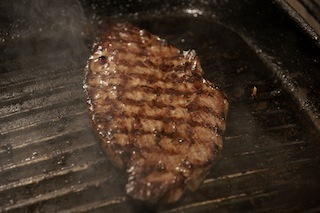
Iron has an unequivocally positive reputation among the general public. After all, pregnant women use it to construct tiny humans, tiny humans use it to become slightly larger, more functional humans, and our cells require it to grow. And in many developing countries, iron deficiency is a real issue. Too little iron can have disastrous effects on cognition, growth, and overall physical robustness. Even adult women who aren’t building tiny humans inside their wombs may run low on iron due to menstrual cycle blood loss. Ask the average person and you’ll hear “the more iron, the better.” Consequently, many countries mandate iron fortification of wheat flour; in the US, we fortify pretty much everything with the stuff because it’s just so, so good for us. Is it true, though?
Not necessarily.
There’s another side to iron. Its inherent proclivity for electron exchange can create free radicals that damage DNA, cells, and blood lipids. Observational studies link iron intake and stored iron to diseases and disease states like type 2 diabetes, heart disease, insulin resistance, inflammation, Alzheimer’s disease, hypertension, fatty liver, hypothyroidism, arthritis, and cancer. The list of disease states connected to excess body stores of iron is impressive and, frankly, daunting. You name it, it’s probably linked to excess iron levels. A huge post on the link between iron fortification and obesity went up at Free the Animal earlier this year. Heck, one researcher even thinks the iron content of tobacco smoke may be responsible for its negative health effects.
Does that mean iron causes these diseases and we should all stop eating red meat forever? No. There’s more to the story, of course, and observational studies can’t prove anything, but the breadth of connections should give you pause.
First, though, figure out if iron is a problem for you. Pregnant women, women who still menstruate, tots, babes, teens, tykes, kids: don’t worry about iron. Don’t stress. Eat and be merry.
Men, particularly those of you getting up in the years? Post-menopausal women? Get your ferritin levels tested. Ignore the suggested normal range, which for men is a massive 18-270 and for women is 18-160. What, are we supposed to believe that a ferritin level of 25 is just as normal as one of 240? Nonsense. There’s a lot of room for things to go wrong there.
A 40-60 range might be ideal, as drops in insulin sensitivity have been seen at slightly higher levels, but don’t quote me on that. The true ideal, if it exists, is likely going to be very personalized. In general, lower is better, as long as you’re not feeling any negative effects (fatigue, hair falling out, poor gym performance, etc).
Although we have mechanisms in place for regulation of iron absorption—and there are many ways we can actively change how much iron we absorb—men of any age and post-menopausal women have no mechanisms to shed excess iron. It can be done, but you have to be proactive and, most importantly, aware of the issue. Your body isn’t going to handle it for you.
So how can we handle things? We can regulate iron levels by altering how we absorb it and taking extra-physiological steps to excrete it. We can also mitigate any negative effects of ingested iron.
Eat a diet rich in polyphenols, flavanols, phytonutrients, and other plant-derived antioxidant compounds. Many of these phytonutrients inhibit iron absorption, and some of the ones we eat show up in our LDL particles where they exert protective effects against oxidants like iron. I’m talking about curcumin (from turmeric), quercetin (from apples, onions, and many other plant foods), grapes—the colorful spices and herbs and plants.
Drink coffee and/or tea with your meals. Coffee inhibits iron absorption (and instant coffee seems to be the most effective!). So does tea, both black and green. Maybe that’s partially why coffee is constantly associated with lower rates of mortality from all causes.
Eat dairy after meals. Dairy, especially the calcium it contains, is a potent inhibitor of iron absorption. More than that, calcium reduces any carcinogenic interactions between heme iron and colonic cells. That’s right; the majority of the animal studies purporting to show a link between red meat/heme intake and colorectal cancer use low-calcium diets or else the cancer won’t “take.” Scared of dairy? Most people can tolerate some form of high-quality dairy, whether it’s kefir, yogurt, hard cheese, or raw milk.
Avoid eating red meat with iron-fortified food. Not only are the two types of iron additive, but they may synergize as heme iron actively increases absorption of non-heme iron.
If you’re going to drink alcohol, make it red wine and lean toward lower-alcohol wines. Its polyphenols inhibit iron absorption, while straight ethanol enhances iron absorption.
Drink mineral water with your meals. High-calcium mineral water can both inhibit iron absorption and reduce the carcinogenicity of heme in the colon.
Train regularly. Intense exercise reduces iron stores. This is a problem for chronic exercises, particularly young women at risk for full-blown iron deficiency anemia, but it can be a helpful strategy for moderate iron reduction and may even explain some of the benefits seen with regular training.
Avoid isolated sources of omega-6 PUFAs. The proposed mechanism mediating the relationship between heme intake and colorectal cancer is heme’s oxidative effect on fatty acids. Which fats are subject to peroxidation, though? PUFAs. In one study, feeding heme iron to rats promoted colon cancer only when fed alongside high-PUFA safflower oil. Feeding MUFA-rich and far more oxidatively-stable olive oil alongside the heme prevented the colon carcinogenesis. In another paper, only mice consuming fish oil-based and safflower oil-based diets exhibited carcinogenic fecal peroxides after eating heme iron; a coconut oil-based group of mice had no negative reaction to heme.
I suspect the association between colon cancer risk and heme iron intake is largely mediated by PUFA intake. Among a cohort of US nurses, high heme intake had moderate links to colon cancer. Among a cohort of Swedish women, the association was far weaker. US intake of PUFA is on the high side, with around 7% of calories coming from PUFA (mostly vegetable oil). Swedish intake of PUFA is under 5% of calories, with a greater proportion coming from fish.
Does this mean you have to ditch all PUFAs? Of course not. Nuts and seeds are good and contain inhibitors of iron absorption that balance out the interaction between the PUFAs and heme iron; refined soybean oil and corn oil just PUFA and little else. If you’re eating lots of polyunsaturated fats with your meat, if you’re cooking your meat in bad oils, or you’re eating meat that’s been cooked in refined high-PUFA seed oils (like most prepared and restaurant food), iron may cause problems.
Give blood (if you’re not already giving it unwillingly). Blood donation, or phlebotomy, is the most effective way to reduce iron stores and tends to increase insulin sensitivity. In insulin resistant men with fatty liver, blood donation normalized insulin sensitivity and liver enzymes. In meat eaters, blood donation reduced ferritin levels to match those of lacto-ovo-vegetarians and improved insulin sensitivity. One study even tested the effect of randomized phlebotomy on cancer incidence. After four and a half years, those subjects placed in the phlebotomy group lived longer, had less cancer, and had lower ferritin levels than the subjects who didn’t donate blood.
Blood donation is the biggest take home from the entire post, if you ask me. You don’t have to adopt an entire new way of eating. You don’t have to take a bunch of supplements. You just go down to the clinic and give some blood. It’s good for you and good for people who need your blood. If you’ve got a husband or family member who refuses to adopt a Primal way of eating, just convince him to give blood. It might really help.
Even though they’re the ones likely to benefit most from it, people with hypertension or type 2 diabetes are usually barred from giving blood. That’s unfortunate and misguided, as little to no evidence exists those groups are any likelier to have adverse reactions to blood donation. I’m not sure what avenue exists for them.
Summing Up
The idea of iron being wholly “bad” doesn’t jibe for me. High-heme red meat intake has trended downward and low-heme poultry has trended up, particularly in the US, yet the metabolic disorders and diseases associated with excess iron are progressing. In the context of a diet rich in refined PUFA oils and iron-fortified cereal grain products and deficient in colorful and phytonutrient-rich fruits, vegetables, chocolate, coffee, and tea with healthy full-fat dairy? Yeah, I can see heme iron adding to the issue.
But rather than give up a nutrient-dense food like red meat (and liver), you can get the best of both worlds by employing the strategies described in this post.
What about you? Ever had your ferritin levels tested? Do you (perhaps unwittingly) use any of the methods described above? Do you give blood? Will you?
Thanks for reading, everyone. Take care and be sure to leave your thoughts below.




November 16, 2015
Dear Mark: Baby Sleep/Feed Schedule and Walking Through a Sedentary Society
 For today’s edition of Dear Mark, I’m answering two reader questions. The first comes from reader Larisa. She is about to give birth, has been hearing the “wake your newborn every 2 hours to feed” recommendation, and wonders how realistic, evolutionarily-congruent, and healthy that will be for new parents desperate for sleep. I offer a few loose recommendations that hopefully make her feel better about what’s about to descend upon her life. Second, is there such a thing as too much low-level activity? Mariel walks 10+ miles a day, strength trains, and stands when she gets tired of walking. Her coworkers think she’s crazy. What do I think? Find out below.
For today’s edition of Dear Mark, I’m answering two reader questions. The first comes from reader Larisa. She is about to give birth, has been hearing the “wake your newborn every 2 hours to feed” recommendation, and wonders how realistic, evolutionarily-congruent, and healthy that will be for new parents desperate for sleep. I offer a few loose recommendations that hopefully make her feel better about what’s about to descend upon her life. Second, is there such a thing as too much low-level activity? Mariel walks 10+ miles a day, strength trains, and stands when she gets tired of walking. Her coworkers think she’s crazy. What do I think? Find out below.
Let’s go:
I’m about to have a baby, and I’m curious about the recommendation I’ve had that I need to wake up the newborn every 2 hours to feed it at night, even if the baby is sleeping and not hungry. Presumably, Grok did not have alarm clocks, and presumably, the extreme sleep deprivation associated with waking up every 2 hours would make the mother an easy prey for whatever preyed on Groks in those days. What would Grok do, and are there Primal recommendations for baby sleep patterns?
Larisa
Sure, if your newborn is sleeping 12 hour stretches right off the bat, something might be amiss. That definitely isn’t typical or normal. And if your baby isn’t gaining weight on schedule, you may need to wake him to ensure adequate calorie intake. If your child was born prematurely, special feeding schedules are probably necessary, and your doctor will give you guidance; heed that guidance. But if everything is going well, just let your baby decide. Finnish newborns eat every 4-6 hours at night, and I strongly believe that’s a good thing. There’s no research behind this, it’s more of a pet hypothesis, but I wouldn’t be surprised if waking and force-feeding kids according to your schedule rather than theirs has an undesirable effect on their ability to self-regulate hunger and satiety.
Consider what you’ve got in a newborn: a pristine force of human nature, the purest expression of what’s intrinsic to humans before environment and culture and upbringing get their claws in and muck about. That child is going to be clued in to whatever he or she needs, moment by moment. If he needs food, he’ll tell you. If he need sleep, he’ll keep sleeping. He’s the best arbiter precisely because he’s just going purely off subconscious physiological urges.
It’d be great if parents could just decide how their newborns slept, fed, and woke. But while there are certainly parents who’ve had success with behavioral sleep interventions, the majority of the evidence for sleep training is weak, nonexistent, or plagued with methodological errors. In my book, the best recommendation is not to impose a top-down sleep schedule for your baby but to consider co-sleeping, bed-sharing, or at least room-sharing because those enable and promote natural sleep patterns. Most pediatrics groups are actually recommending that parents room-share with their newborns because the evidence in favor is so overwhelming (although they still oppose bed-sharing).
Co-sleeping hews your sleep wake schedule to your baby’s (or maybe it’s vice versa) so you’re in tune with each other—naturally. It also changes how you perceive the wake-up. In one study, co-sleeping parents rated their night wake-ups as less disruptive than parents who slept apart from their babies. Turns out your 2 month-old son nuzzling your neck and murmuring baby nonsense into your ear is a better way to wake up than your 2 month-old wailing from another room. Who knew?
All this means you can react to the baby’s immediate needs immediately rather than try to guess with arbitrary wake-up and feeding times. Also, you’re less likely to be angry and stressed out when you do wake up (you’ll still be a little angry and stressed, of course, and that’s okay!).
Too often, parents assume their newborns are fleshy vegetables unable to accept sensory data. They’re just there, completely helpless and passive. Really, kids absorb that stuff and are subject to the same laws as us. They may not be able to think about the blue light they’re seeing, but it still affects them. Minimize circadian disruptions for the baby just as you would for an adult. That means:
Lots of light during the day. Babies who receive ample daytime light, especially natural light (yes, a bit of sunlight is perfect safe for infants) during the afternoon, are more likely to sleep better at night.
Keep the TV and electronics off once it gets dark. Don’t bathe your baby in blue light then wonder why she refuses to sleep.
The basic stuff that works for us applies to your baby, too.
In short, your child will have strong opinions about Primal sleep patterns. They’re probably right and you should listen.
How much low level movement is too much?
I have a treadmill desk that I average 10 miles a day on. I also usually add in a gentle bike ride and there is always some outdoor walking, as well.
I also exercise (body weight and plyometric exercises plus kettlebells) most mornings.
People are freaked out by how much I walk. When I’m tired I stop walking and stand at my desk, so I don’t really see the problem. I do have an “all or nothing” type of personality in general, though.
Do you think there is such a thing as too much walking and low level movement?
Thanks so much for any input! I really value the opinion of MDA!
Mariel
People are freaked out because you live in a sedentary society where people take the elevator to go up or down one floor. Where instead of using their legs, they use moving staircases. Where rather than grab the first parking spot they see, people will drive for ten minutes just to get one near the entrance. When you see these examples written out, they sound preposterous. Moving staircases? C’mon! But they’re normal, and most of us fall into the same patterns without thinking.
You’re not, and that’s weird and threatening.
I’m a little jealous of you. 10+ miles a day? Dang. I wish I could manage that much.
Let me avail your concerns: you’re probably okay. If modern hunter-gatherers like the Ache or Hadza are any indication (PDF), our ancestors walked anywhere from 6 to 16 kilometers on an average day. Another recent study pegs the Hadza as walking between 6 and 11.5 km a day on average, with women walking toward the lower end of the range and men toward the higher. Those aren’t quite 10 miles per day, but modern examples exist, too. There are rural South African women, of whom just 11.9% can be classified as sedentary (under 5,000 steps a day) and for whom an average day means walking 10,594 steps or just over 5 miles (many of them done while carrying a load). Most impressive are the Amish men and women aged 18-75 (PDF), who walk an average of 18,425 steps (about 9 miles) or 14,196 steps (about 7 miles) each day respectively.
If you’re getting enough food, have at it. If you still have the energy to do your work and train, keep up the miles. I’d say if walking starts cutting into your ability or willingness to lift heavy things (or bodyweight/kettlebells), reduce the walking and keep the training. Ten miles a day plus strength training is better than 14 miles a day and no additional training. Low level movement is the foundation, but those short, intense bouts of dedicated training are indispensable.
As always, folks, fill in any gaps in my answers down below with your comments. You’re a huge wealth of knowledge; let it shine!
Thanks for reading, everyone. Take care.




November 15, 2015
Weekend Link Love – Edition 374

Research of the Week
Leg strength at baseline was the best predictor of cognitive function over ten years in older women. Aware of the huge possibility for confounds, the researchers even used twins to eliminate genetic explanations.
Cooking with vegetable oils is indeed really, really bad for you. I swear I’ve heard that somewhere before.
Exercising before, but not after breakfast increases 24-hour fat oxidation.
New Primal Blueprint Podcasts

Episode 93: Tony Federico: Host Elle Russ sits down with Paleo Magazine editor Tony Federico. Tony ditched his binge eating and addiction to exercise after reading Loren Cordain’s The Paleo Diet and some book called The Primal Blueprint. Now, he edits the top paleo magazine, trains clients, blogs, writes cookbooks, podcasts, and has just developed a professional development program for coaches called Prime Time Trainer. He’s a busy guy with a lot to say.
Each week, select Mark’s Daily Apple blog posts are prepared as Primal Blueprint Podcasts. Need to catch up on reading, but don’t have the time? Prefer to listen to articles while on the go? Check out the new blog post podcasts below, and subscribe to the Primal Blueprint Podcast here so you never miss an episode.
Blindspots Even Informed Paleo Enthusiasts Often Have
15 Alternatives to Sitting Meditation
Stop Saying No, Start Saying Yes!
Also, be sure to check out and subscribe to the Primal Endurance Podcast.
Weekly sweepstakes: Write a review for The Primal Blueprint Podcast or The Primal Endurance Podcast on iTunes and submit this form for a chance to win a Primal prize package. One new winner is chosen every week!
Interesting Blog Posts
3D printing promises to change how we look at human evolution.
Media, Schmedia
Obesity’s still rising in the US.
Might be why people are radically changing how they eat en masse.
The French president won’t dine with the Iranian president unless wine is present, and the Iranian president won’t dine with the French president if wine’s at the table.
Everything Else
Can we use stationary bikes to power our homes?
Haggis manufacturers want in on the US market, and they’re willing to remove sheep lung from the recipe to satisfy safety regulation.
The FDA finally recommended upper limits for added sugar intake: 12 teaspoons a day. Don’t get too crazy, there, FDA!
f.lux was available on iOS for a day or two, but Apple yanked it.
The man who invented relaxation.
Can co-housing bring back the village?
While you wait for the Primal challenge to roll around, give this clean eating challenge a shot. Be sure to read it very, very closely.
Recipe Corner
Morning egg muffins make breakfast easy.
True onion lovers, try creamy onion soup.
Time Capsule
One year ago (Nov 17–Nov 23)
How to Support Healthy Skin Bacteria – It’s there. What are you going to do about it?
8 Strategies for Cultivating a Vitality Mindset – Get your mindset right.
Comment of the Week
“I, for one, welcome our new canine overlords”
– Me too.




November 14, 2015
Waffle Iron Sweet Potato Hash Browns
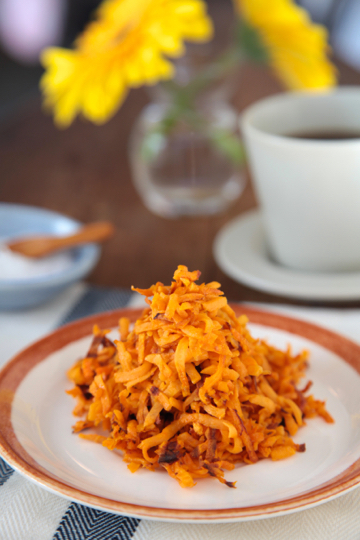 Sweet potatoes have a lot going for them as a breakfast potato of choice. Shredded into hash browns, they make a bigger flavor statement than regular old potato hash browns, and the sweetness is a perfect contrast with salty bacon and eggs.
Sweet potatoes have a lot going for them as a breakfast potato of choice. Shredded into hash browns, they make a bigger flavor statement than regular old potato hash browns, and the sweetness is a perfect contrast with salty bacon and eggs.
Sweet potatoes are also strong sources of beta-carotene, manganese, and copper and safe sources of starch.
Sure, sweet potato hash browns can be cooked in a skillet. But if you have a waffle iron in the back of the cupboard that’s not being used for waffles any more, then pull it out. A waffle iron quickly and easily turns shredded sweet potatoes (and regular potatoes) into hash browns. The strings of sweet potato are both tender and crispy, with sweet, buttery flavor. Pile them high on plate and they’ll fly off the breakfast table (and the dinner table, too).
Recipe note: This recipe works best using a waffle iron with temperature control. Set on medium, the sweet potatoes will cook in the middle and brown nicely on the outside. Waffle irons without temperature control are likely to get too hot, and the hash browns are more likely to burn.
Servings: 4
Time in the Kitchen: 15 minutes
Ingredients:
2 sweet potatoes (about 10 ounces/284 g each), peeled and grated/shredded
1/2 teaspoon kosher salt (2.5 ml)
Butter (or ghee), to grease waffle iron
Instructions:
Preheat waffle iron. If it has temperature controls, set it to medium.
Wrap the sweet potatoes in a thin towel and squeeze repeatedly to remove as much moisture as possible. It’s not likely that much moisture will come out, probably just enough to make the towel damp.
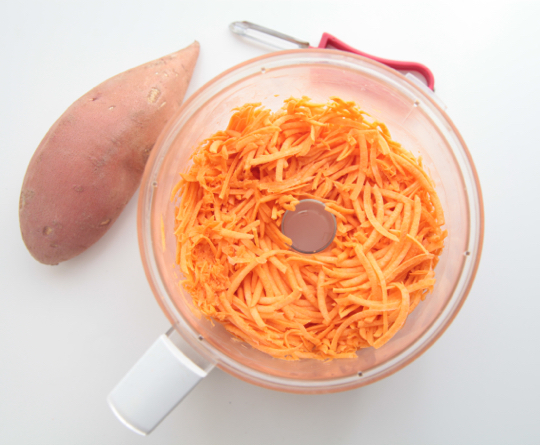
In a large bowl, toss the sweet potatoes with salt.
Carefully grease the hot waffle iron liberally with butter.
The amount of shredded sweet potatoes to cook at once and the exact cooking time will vary depending on the size of the waffle maker. Think of your first batch as an experiment for both. Put in enough shredded potatoes so the waffle iron seems just a little too full; when you close the lid it will press the potatoes down and make them fit.
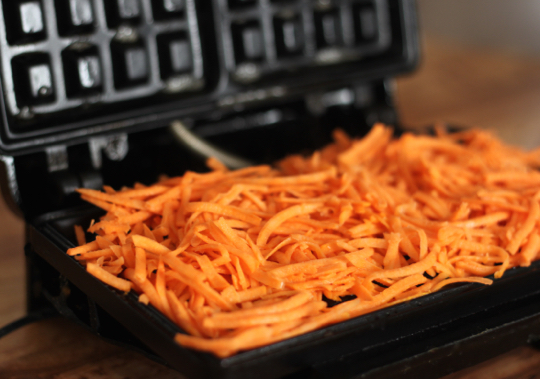
Start checking the hash browns after 5 minutes. It’s likely the total cooking time will be around 8 minutes. You’re looking for hash browns that are nicely browned and crispy at the tips. However, even sweet potatoes that aren’t brown and crispy all over will taste great.
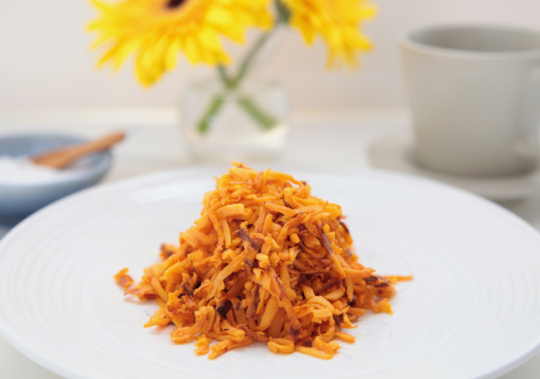




November 13, 2015
Community: The Missing Piece of My Primal Story
It’s Friday, everyone! And that means another Primal Blueprint Real Life Story from a Mark’s Daily Apple reader. If you have your own success story and would like to share it with me and the Mark’s Daily Apple community please contact me here. I’ll continue to publish these each Friday as long as they keep coming in. Thank you for reading!
 I wanted to share with you and your readers my love of the activity known as AcroYoga, or sometimes Acrobatic Partner Yoga. I think of it as the missing piece that really brought my primal lifestyle full circle and improved my life!
I wanted to share with you and your readers my love of the activity known as AcroYoga, or sometimes Acrobatic Partner Yoga. I think of it as the missing piece that really brought my primal lifestyle full circle and improved my life!
A little bit of background about me: I’m 26 years old and I’ve been following PB for about four years. I first found MDA when my best friend, now partner, Alex shared a recipe from the site. I started reading and couldn’t stop. Before going primal, I’d always been pretty healthy and in shape, but I was plagued by body image issues, and was constantly counting calories and punishing myself for eating too much. Primal life changed that for me. I learned the difference between calories and nutrition, and started to feel good about the food I ate. I went strictly Primal for a while before I found the healthy balance that worked best for my metabolism. I really feel like I’m living my best life now!
When I first tried Acro three years ago, I had already been following a mostly Primal lifestyle for a year or two: getting plenty of sleep, eating my healthy fats, eschewing grains and sugars, and exercising. I had lost fat, gained muscle, my endurance had increased to 11, and I had some nice muscle definition. I had heard about AcroYoga and thought it seemed cool, so when I found out that there were some people at the park who were doing it, I rushed down to try it! I immediately fell in love, and within a year it had taken over as my main form of exercise. I’d never experienced a core work out that was both effective and fun, but this is it! After all those years of training and daily exercise, I never had abs until now. My flexibility, which has always been exceptional, is even better now. I can do handstand push-ups and back-bends, one legged side planks and splits. I’ve never felt stronger, happier, or more balanced.
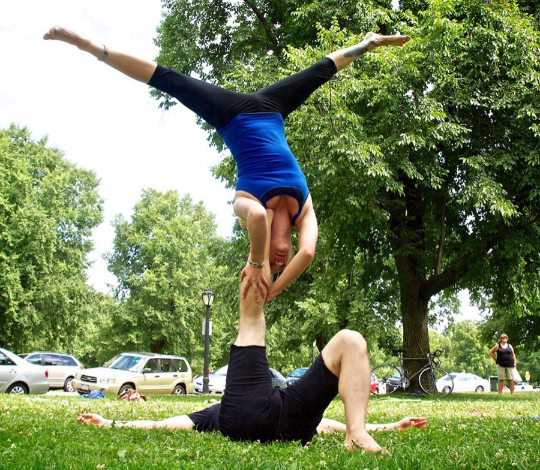
Me flying with my friend Ben basing
But the greatest benefit of doing AcroYoga and the reason why I think it might be one of the most “Primal” activities a person could do, is the sense of community love and support I have gained. We’re always talking about that hunter-gatherer lifestyle, in which our primal ancestors lived in nomadic extended family groups, helping and supporting one another, working together, and of course all of that time was spent outdoors. But I think with all our eating well and outdoorsy endurance exercises, we often neglect that familial bonding aspect of Primal life, and don’t realize how crucial a community structure really is to our well-being. AcroYoga is the first form of exercise I’ve tried that really embodies it perfectly, and at the same time gives me a great low-impact, full-body work out. It is body-weight exercise at its most essential. You don’t need any special equipment for Acro, just a friend and a healthy appreciation for the versatility of your own body.
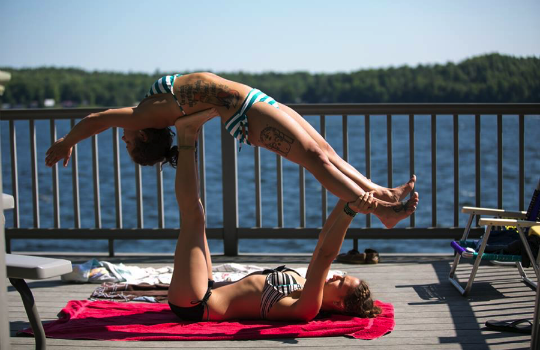
That’s me basing my friend Beth
My hometown is Buffalo, NY, beautiful (read: hot and humid) in the summer, and chilly (read: eight feet of snow and sub-zero temps) in winter. There are other cities that are warmer, there are other cities that have oceans and mountains, but there is no city like the City of Good Neighbors. I practice with a community called AcroYoga Buffalo, and like our primal ancestors, we are nomads. By that I mean that in most other cities with an Acro community, that community has one or more definite “home” facilities where they practice regularly and take scheduled classes. AcroYoga Buffalo doesn’t own a space, but rather borrows spaces from whomever is kind enough to open their doors to us. In the summer, we are always outside. We meet in public parks and farmer’s markets and hang out together, sharing food and laughs, enjoying the warm sun, the people, and practicing AcroYoga. Our gatherings, which we call Acro Jams, are free and open to the public. Anyone who walks by our jam is welcome to join us, even if they’ve never tried yoga and can’t even touch their toes. Even though it looks tough, beginner poses are surprisingly achievable, and no one ever walks away without a smile of accomplishment on their face. We celebrate those accomplishments with hugs and high-fives and the knowledge that we’ve made new friends.
In AcroYoga we usually have two partners: a base, who stays connected to the earth, and a flyer who stays connected to the base. It’s amazing the way we seem to draw our energy up from that connection with the earth, through the base for it to come radiating out of the flyer. It feels natural and necessary to interact with other humans and the earth in this way, it feels like something we need.

“Base Camp”- me flying with a visiting teacher while the bases gather round to learn the move from their perspective
As the weather gets colder, we retreat indoors to community spaces that allow us to practice there on a donation basis, which means anyone can afford to come. When winter descends upon us, our close community draws even closer, and our bonds are strengthened by something similar to the Danish concept of “hygge-” that cozy feeling of togetherness, that feeling you get from sharing time with family and friends that makes you feel warm inside even if it’s bitterly cold outside. The sense of playfulness is tangible- this practice is really fun! I think you would agree that it’s important for adults to engage our inner child in a little play time, and when winter lasts six month or more, it’s extra important that we generate that happy, goofy energy that keeps us going. It’s an inner light during days when we don’t see much sun.
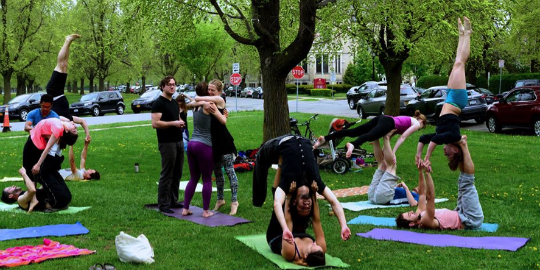
Lots of fun and hugs at one of our outdoor jams
But even in non-nomadic Acro Communities, those who are lucky enough to have a home space, this feeling of fun, cozy togetherness persists regardless of the season through the innate quality of the Acro practice which involves close personal contact and intimacy. In yoga, there is this concept of loving-kindness, where we strive to listen to our bodies, push ourselves when we need a challenge, and rest when we need a break. We accept the level where we are currently, and celebrate new achievements. In AcroYoga, these principles extend from ourselves out to another person, our partner who practices with us. We listen to our partners’ bodies and share new skills with one another. We bring in a third partner, the spotter, to catch us when we fall while trying challenging new acrobatic moves. They protect us from taking nasty falls and they also offer the comfort of knowing that you have a friend nearby with open arms. Sometimes just that knowledge is all you need to accomplish something new!
AcroYoga has two sides, the acrobatic side, and the therapeutic side; solar and lunar. In lunar therapeutics, we extend this concept of loving-kindness even further through massage and assisted stretching techniques. It’s a unique way to express gratitude to a friend and rewarding to make another person feel good.
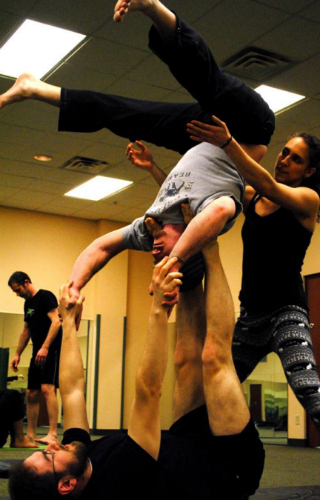 Try mixing Acro into your Primal routine! If all the hippy-dippy love-fest talk wasn’t enough for you, maybe the intense core work is! Acro is accessible to all levels regardless of strength or flexibility, but you’ll be amazed at how quickly those areas improve as you practice. Bases earn incredibly flexible hamstrings and can squat for days, while fliers develop an iron core and superhero deltoids. Personally, I now have control over deep-layer muscles in my belly, sides, and back that I never knew I had! Since this practice has so much focus on balance, it’s the unconscious control of the smallest core muscles that make it all possible. Acro is for everyone, and we engage with the very old, the very young, yoga experts and complete beginners alike.
Try mixing Acro into your Primal routine! If all the hippy-dippy love-fest talk wasn’t enough for you, maybe the intense core work is! Acro is accessible to all levels regardless of strength or flexibility, but you’ll be amazed at how quickly those areas improve as you practice. Bases earn incredibly flexible hamstrings and can squat for days, while fliers develop an iron core and superhero deltoids. Personally, I now have control over deep-layer muscles in my belly, sides, and back that I never knew I had! Since this practice has so much focus on balance, it’s the unconscious control of the smallest core muscles that make it all possible. Acro is for everyone, and we engage with the very old, the very young, yoga experts and complete beginners alike.
Is Acro Primal? You bet! Sure Grok probably wasn’t doing handstands on his friends, but he was spending time outdoors, using his body weight, getting dirty, and he was doing it while surrounded by a tight familial support group. I encourage everyone to try it if you’re looking to step up your work out, try something different, meet new friends, and impress yourself with what you can do! Before I started doing Acro, I was in great shape, but something was missing from the very core of my humanity. Working out was great, but I think what I really needed to fulfill my Primal needs was to be surrounded by this grateful, loving extended family, who are always there to catch me when I fall.
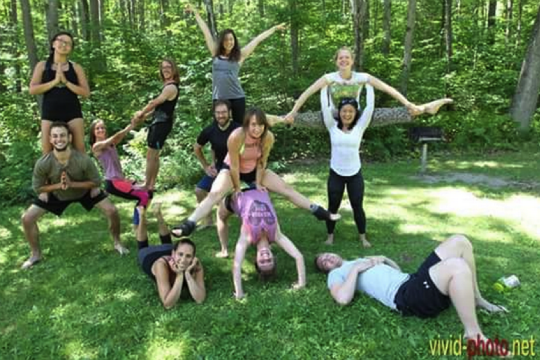
Me and my Acro Family at camp
Happy Flying,
Juliana
Photo Credits: Glen Murray, Matthew Grant, and Robert Strukelj




November 12, 2015
What’s Behind Your Poor Health: Life vs. Lifestyle Issues
 One of the things I love about our success stories is the far-reaching impact of people’s health transformations. They lose weight (or in some instances gain it in muscle mass). They get fit. They get their basic health in order, and the physical vitality takes on a life of its own with a unforeseen “carry-over” effect, leaving them happier, more confident and newly inspired to pursue other personal goals or productive changes in their lives. This got me thinking about how much the opposite holds true. What about the studies that tell us negative circumstances in our lives become risk factors for a variety of serious health issues, including mortality risk itself?
One of the things I love about our success stories is the far-reaching impact of people’s health transformations. They lose weight (or in some instances gain it in muscle mass). They get fit. They get their basic health in order, and the physical vitality takes on a life of its own with a unforeseen “carry-over” effect, leaving them happier, more confident and newly inspired to pursue other personal goals or productive changes in their lives. This got me thinking about how much the opposite holds true. What about the studies that tell us negative circumstances in our lives become risk factors for a variety of serious health issues, including mortality risk itself?
The thing is, we focus a great deal on the proximate causes of obesity and lifestyle disease (e.g. what people eat, how much they eat, what metabolic issues come into play), but sometimes the actual headspring could be considered “Life” rather than lifestyle issues—negative relationships, family dynamics or job situations, etc. that admittedly don’t force people toward unhealthy behaviors but leave too many of them groping for these as coping mechanisms. From there, the spiral begins. This isn’t to oversimplify the situation or to deny individuals responsibility for their own choices, but it raises a legitimate question: to what extent can getting our lives in order open the door to better health?
We see the headlines on a regular basis linking negative life circumstances or poor quality of relationships to poor health. The latest this week connected the “ambivalent marriage” (in which negative interchange is frequent but not constant and often unpredictable) with higher blood pressure. Research has previously associated hostile and consistently unsupportive marriages with the likes of higher systemic inflammation, slower wound healing, dysregulation of immune function and stress hormone alteration. Likewise, job stress and, in particular, job burnout can raise workers’ use of medical services as well as their risk for stroke and other cardiovascular disease.
While this brand of research relies heavily on self-report and often doesn’t narrow the variables to any gold standard, it’s hard to argue with the results. We know people in these situations or perhaps have been in them ourselves. We can identify or sympathize with what it means to live in an unhappy relationship, to feel lonely, to be in the wrong profession or dread our work environments, to live with various unresolved issues from our past. It’s hard to not feel the toll over time of chronic negative interactions at home, in the workplace or in an extended family or other social structure.
And so the coping begins…. Some people lean into healthy behaviors like exercise that may stay healthy or take on compulsive dimensions. Others begin to turn to less healthy “shadow” comforts like night eating, overeating or “comfort” eating, drinking or smoking, zoning out with sedentary screen time or overworking and undersleeping. An entire psychic-physiological helix gets set in motion, but the portion locking in the entire pattern is that original catalyst—that negative, eventually disempowering “Life” circumstance (or at least our fixed reaction to it).
While I’m not one to let people off the hook for their own choices, I think we know how this goes. People go into denial or feel trapped, “feed/medicate” the gloomy emotions with unhealthy behaviors, thinking that it’s a temporary situation or that they’ll figure some way out of this mess but just for today they need something to take the edge off. “Today,” all too often, becomes many days until it becomes routine. Their motivation to change anything in their lives, including their health, generally dwindles over time. Between the imposed stresses of the core circumstances and added descent into other unhealthy choices, they’re caught and now increasingly at risk for a host of stress related conditions, which (not surprisingly) are also the most common “lifestyle” diseases/conditions like cardiovascular disease, obesity, diabetes, depression, gastrointestinal conditions and premature death.
We might in these instances be able to identify which came first (the chicken or the egg), but when we can truly trace poor health back to an unfortunate Life situation, where should the most effective approach begin? Should it be following the general prescribed route of adopting healthy lifestyle choices, or should it be pulling up and finally bringing to resolution that initial rotten root. In other words, do you fix the Life or the lifestyle first?
Some months ago I wrote that getting healthy can be an incredible boon to our vitality and equanimity (and, by extension, all good things these factors can foster in our lives), but it is not a panacea. Getting in shape or losing fifty pounds isn’t an automatic fix for all else we struggle with in life, whether it be a toxic work environment, a precarious financial situation, or a dead-in-the-water marriage. Eating a great diet and running a series of 5Ks might make us feel more energetic and raise our self-esteem, but it won’t erase an unreasonable commute that leaves us with too little family time. It won’t eradicate past trauma. It won’t resolve the grief of a major loss.
What health can give us is a more formidable resilience within our lives, a stronger buffer against the impact of stress in its various manifestations. It can offer us a bigger reserve of emotional and physical energy to work with in life, but it doesn’t by any means wipe our slate clean.
Uprooting a festering situation that’s been weighing us down for long stretches of time can be freeing. It can dislodge our lives from seemingly immovable patterns. We can realize with a mixed bag of relief and consternation how much energy and attention that certain situation has drained from us for how many months, or year, or even decades.
And yet… If we’ve allowed ourselves (yes, allow) to go down those rabbit holes of self-denial, of self-diminishment, of self-destruction physically and emotionally, it’s probably unreasonable to believe that shifting an outer circumstance is going to be enough to dissolve all the negative patterns within our daily structure and the defeating self-talk that we’ve amassed (and internalized) within our own mentality.
I believe these situations, should we identify our issues in this way, call us back to the question of health integrity. At some point along the way, we gave away our own health step by step in the name of coping, in the name of avoiding, in the name of abdicating our responsibility. When we’re ready to face the facts of our “Life” conflict, we’re finally poised to cut our excuses off at that original root, but it’s also important to understand they can (and in all likelihood have) become self-perpetuating.
We have to do more than “fix” a problem we situate outside of ourselves. We have to reclaim our own authority. That means we clean up our own patterns by doing the footwork of health and self-care. We acknowledge that we’ll earn that vitality back by our own efforts. Blame has no more place in our day—from either end.
In the end, maybe it’s about finally asserting that our health has the best chance to flourish when our Life (the big choices, relationships and priorities of our lives) and our lifestyle (the details we live regularly) fully correlate.
Thanks for reading, everyone. Do you identify your own situations with this question? What was the answer for you along the way? Share your thoughts in the comment section, and have a great end to the week.




Mark Sisson's Blog
- Mark Sisson's profile
- 199 followers



